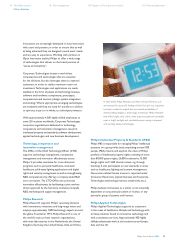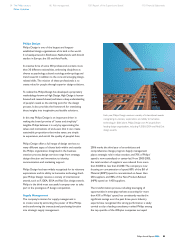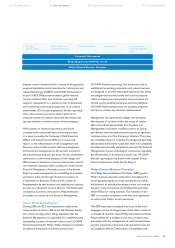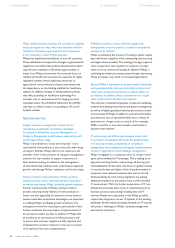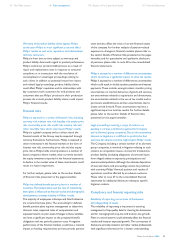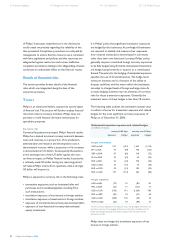Philips 2006 Annual Report Download - page 88
Download and view the complete annual report
Please find page 88 of the 2006 Philips annual report below. You can navigate through the pages in the report by either clicking on the pages listed below, or by using the keyword search tool below to find specific information within the annual report.
Philips Annual Report 200688
the GBP is an integral part of the annual statement
on business controls that has to be issued by the
management of each organizational unit. The GBP
incorporate a whistleblower policy, standardized
complaint reporting and a formal escalation procedure.
The global implementation of the One Philips Ethics Line
was completed in 2006. This will ensure that all alleged
violations are registered and dealt with consistently
within one company-wide system. Due to country-
specifi c constraints Germany (where the approval of
worker’s representation bodies is required) and France
(where approval is required from the privacy authorities)
did not participate in the One Philips Ethics Line. Philips
is striving to obtain these approvals in order to allow
comprehensive company-wide implementation.
To drive the practical deployment of the GBP, a set
of directives has been published, including a Supply
Management Code of Ethics and a Financial Code
of Ethics (www.philips.com/about/investor). The GBP
Directives were updated in 2006, refl ecting ongoing
developments in codes of conduct and business integrity
legislation. The main updates related to Philips’ endorsement
of the UN Global Compact, policy on HIV/AIDS, health
and safety policy, integrity and ethics in advertising, and
in particular directives on the giving of gifts. To ensure
compliance with the highest standards of transparency
and accountability by all employees performing important
fi nancial functions, the Financial Code of Ethics contains,
amongst other things, standards to promote honest and
ethical conduct, and full, accurate and timely disclosure
procedures to avoid confl icts of interest. The Company
did not grant any waivers of the Financial Code of Ethics
in 2006. To reinforce awareness of the need for compliance
with the GBP, a web-based GBP training tool has been
rolled out throughout the world in 18 different languages.
This tool is expected to cover more than 90% of Philips
employees with internet/intranet access by the fi rst
half of 2007.
In 2006, an e-Learning Tool for job training of (new)
compliance offi cers (including complaint-handling
procedures and dilemma training) was rolled out.
This course is mandatory for all GBP Compliance
Offi cers and will be updated and repeated each year.
Risk categories
Taking risks is an inherent part of entrepreneurial
behavior. A structured risk management process
encourages management to take risks in a controlled
manner. Philips has a structured risk management process
in place that recognizes different risk categories at Strategic,
Market/Business environment, Operational, Financial
and Compliance and fi nancial reporting level.
Within Strategic business risks Philips covers areas that
infl uence Philips’ strategic opportunities and threats, such
as risks related to innovation and differentiation. The
Market/Business environment risks cover the effect that
changes in the market may have on Philips. Risks related to
areas such as economic and political development and power
concentration are likely to affect all market participants
in a similar manner. Operational risks include adverse
unexpected developments resulting from internal processes,
people and systems, or from external events that are linked
to the actual running of each business (examples are
product creation and supply chain management). Within
the area of Financial risks Philips identifi es risks related
to Legal, Treasury, Pensions and Fiscal. Compliance and
fi nancial reporting risks cover unanticipated failures to enact
appropriate policies and procedures and risks that could
negatively impact Philips’ reliability of fi nancial reporting,
correctness of disclosures, and safeguarding of assets.
Strategic business risks
Innovation and identifi cation of new sources
of differentiation are important to realize Philips’
profi table growth ambitions.
Philips’ longer-term success depends on, amongst other
things, innovation based on end-user insight using
technology as value enabler. Moreover, some of Philips’
divisions continue to face diminishing opportunities to
differentiate on the basis of technical performance only.
This makes the identifi cation of new sources of both
tangible and intangible differentiation essential.
Concurrently, it is imperative to understand changes in
patterns related to end-user needs and preferences, and
to align differentiation initiatives and innovations with the
brand promise of “sense and simplicity”. If Philips fails in
this area its growth ambitions may be hampered.
6 Financial highlights 8 Message from the President 14 Our leadership 20 The Philips Group



